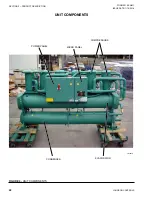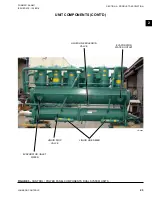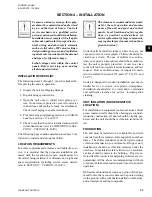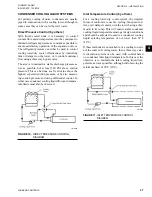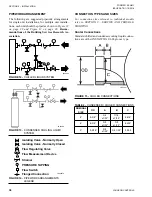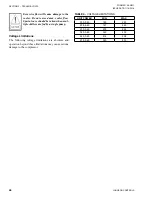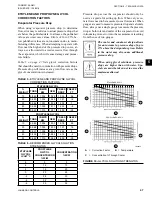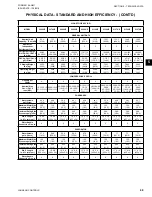
SECTION 4 – INSTALLATION
FORM 201.26-NM1
ISSUE DATE: 1/19/2018
JOHNSON CONTROLS
35
4
• Drain and air vent connections should be provided
at all low and high points in the pipework to per-
mit drainage of the cooler and system, and to vent
any air in the pipes.
• Liquid systems at risk of freezing, due to low am-
bient temperatures, should be protected using in-
sulation and heater tape and/or a suitable glycol
solution. The liquid pump(s) must also be used
to ensure liquid is circulated when the ambient
temperature approaches freezing point. Insulation
should also he installed around the heat exchanger
nozzles.
• A small valve or valves should be installed at the
highest point or points in the chilled water piping
to allow any trapped air to be purged. Vent and
drain connections should be extended beyond the
insulation to make them accessible.
• Piping must comply in all respects with applicable
local plumbing codes and ordinances. In no case
should the unit support the weight of connecting
piping. Since elbows, tees, and valves increase
pressure drop, all piping should be kept as simple
as possible. Hand stop valves should be installed
where required to facilitate servicing. Piping to
the inlet and outlet connections of the evaporator
and condenser may include high-pressure rubber
hose or piping loops to ensure against water pump
transmission of vibration.
• Facilities should be provided for measuring
temperature and pressure in the evaporator and
condenser field water piping. Drain connections
should be provided at all low points to permit com-
plete drainage of the evaporator(s), condenser(s),
and system piping. This is especially important
if the unit is located in an unheated room where
freezing could prevail. Water lines subjected to
ambient temperatures below freezing may require
heater cables or antifreeze (by others).
Any debris left in the water pipework
between the strainer and heat exchanger
could cause serious damage to the tubes in
the heat exchanger and must be avoided.
The installer/user must also ensure that
the quality of the water in circulation is
adequate, without any dissolved gasses
which can cause oxidation of steel parts
within the heat exchanger(s).
The flow switch MUST NOT be used to
start and stop the chiller (i.e. starting
and stopping the chilled water pump). It
is intended only as a safety switch. It is
recommended to interlock the auxiliary
contacts of the pump contactor in series
with the flow switch. The coil of the pump
contactor must have a voltage suppressor
installed across the terminals.
The heat exchangers must not be exposed
to flushing velocities or debris released
during flushing. It is recommended that
a suitably sized by-pass and valve ar-
rangement be installed to allow flushing
of the pipework system. The by-pass can
be used during maintenance to isolate the
heat exchanger without disrupting flow to
other units.
Liquid systems at risk of freezing, due
to low ambient temperatures, should be
protected using insulation and heater tape
and/or a suitable glycol solution. The
liquid pumps must also be used to ensure
liquid is circulated when the ambient
temperature approaches freezing point.
Insulation should also be installed around
the heat exchanger nozzles.
Содержание YCWL0056SE
Страница 4: ...FORM 201 26 NM1 ISSUE DATE 1 19 2018 JOHNSON CONTROLS 4 THIS PAGE INTENTIONALLY LEFT BLANK...
Страница 30: ...FORM 201 26 NM1 ISSUE DATE 1 19 2018 JOHNSON CONTROLS 30 THIS PAGE INTENTIONALLY LEFT BLANK...
Страница 146: ...FORM 201 26 NM1 ISSUE DATE 1 19 2018 JOHNSON CONTROLS 146 THIS PAGE INTENTIONALLY LEFT BLANK...
Страница 154: ...FORM 201 26 NM1 ISSUE DATE 1 19 2018 JOHNSON CONTROLS 154 THIS PAGE INTENTIONALLY LEFT BLANK...
Страница 168: ...FORM 201 26 NM1 ISSUE DATE 1 19 2018 JOHNSON CONTROLS 168 THIS PAGE INTENTIONALLY LEFT BLANK...
Страница 186: ...FORM 201 26 NM1 ISSUE DATE 1 19 2018 JOHNSON CONTROLS 186 NOTES...


